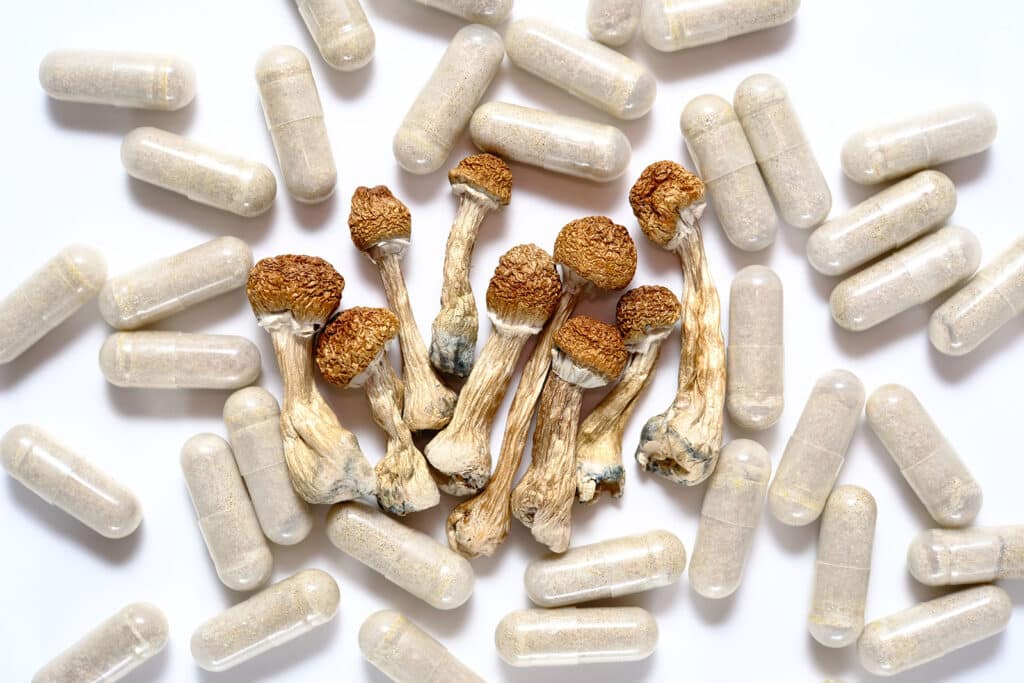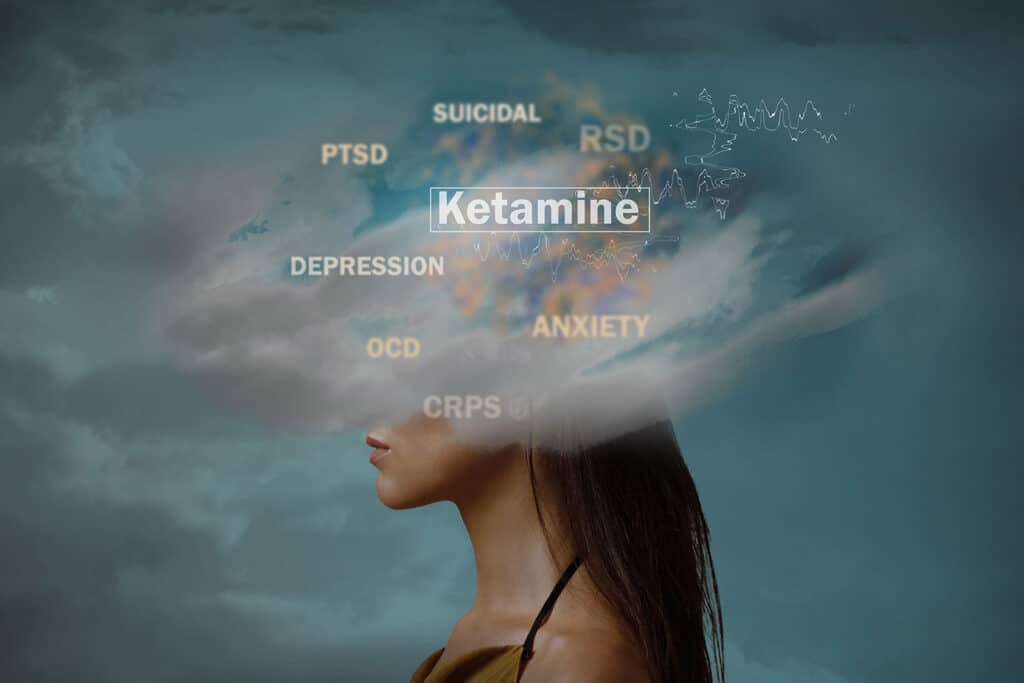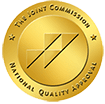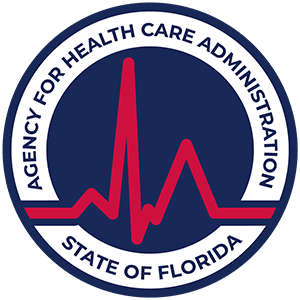TL;DR – Most people start to feel the effects of the magic mushrooms within 20 to 40 minutes.
Are you curious about magic mushrooms? Magic mushrooms are a species of psilocybe fungi. These mushrooms grow on nearly every continent, and various cultures have used them for thousands of years as part of their religious ceremonies. Today, magic mushrooms are often referred to as shrooms or mushrooms, and they’re known for their hallucinogenic properties. Let’s explore magic mushrooms, why they’re increasing in popularity, and the effects of consuming them.
What Are Magic Mushrooms?
The magic mushrooms found in the United States, Central America, and Mexico have long, thin stems and dark gills on the undersides of the semi-flat caps. Magic mushrooms are, well, mushrooms, and they contain psilocybin, which is a psychedelic or hallucinogen. This means that the drug causes people to see and hear things that are not there. This psilocybin is converted by the body into psilocin, the psychoactive compound responsible for the effects. The mushrooms can be consumed fresh, dried (dried mushrooms), dehydrated, as a powder, or brewed as a mushroom tea.
Magic mushrooms or shrooms saw an increase in popularity in the 1960s because researchers began studying psilocybin. They were researching to find out if the chemical had any medical uses. At that time, no medical uses were found, and psilocybin was classified as a Schedule 1 drug. However, research on magic mushrooms is still ongoing, and over the last several decades, shrooms have only gotten more popular. Currently, psilocybe fungi (one of the many types of mushrooms that contain psilocybin) are being researched to see if they have any positive effects for various mental illnesses, and so far, they have shown promise for treating depression and PTSD. They may also help with end-of-life care.
In order to further explore psilocybe fungi, the University of Utah partnered with the Natural History Museum of Utah to discover the history of the plants. The researchers discovered two distinct gene orders, and they hypothesize that psilocybe fungi have been on the planet for about 65 million years.
Due to all of the ongoing research, some states have opted to lessen their regulations and laws on psilocybe fungi so that their medical uses can be studied. The researchers at the University of Utah hypothesize that in order for psilocybe fungi to be useful, new extraction methods and therapies will need to be developed in order to improve their effectiveness.
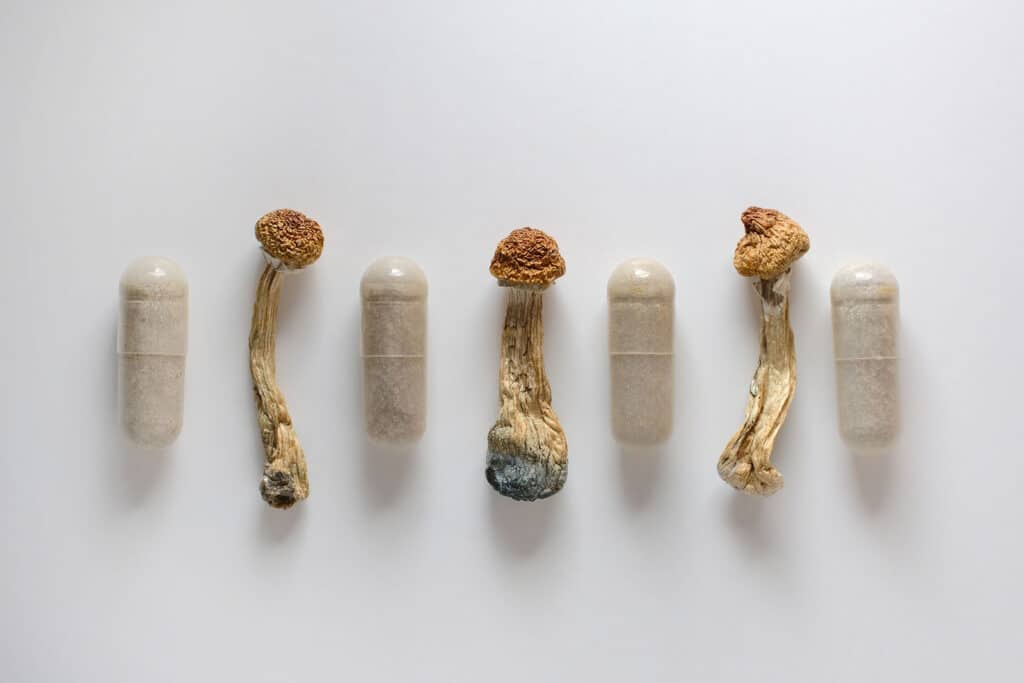
How Do Psychedelic Mushrooms Affect the Brain and Perception?
Psychedelic mushrooms can cause people to feel euphoric, and they can cause hallucinations. Psilocybin works by activating the serotonin receptors in the brain. Users of psilocybin often report hearing distorted sounds and seeing weird images. The psilocybin has the ability to temporarily change the way the brain functions. In essence, it desynchronizes the brain’s default pathways, specifically the areas of the brain that are active when the brain isn’t being used for anything specific. This desynchronization lasts for the duration of the ‘trip’. Then, those areas reestablish their connections.
How Long Does It Take Magic Mushrooms to Take Effect?
Dried and fresh psilocybin mushrooms are typically eaten or brewed into tea, and the stomach must have time to process them. As a result, most people start to feel the effects of the magic mushrooms within 20 to 40 minutes. Factors like whether they are taken on an empty stomach can influence the onset of effects. As the shrooms start to take effect, most people notice colors becoming brighter and quiet sounds becoming more noticeable. While some individuals experiment with microdosing, consuming higher doses can significantly alter the experience and should be approached with caution.
Factors That Influence Onset Time
Several factors can influence how long it takes the mushrooms to kick in.
- Eating Prior to Consuming the Mushrooms – If an individual eats before consuming the shrooms, it can increase the time it takes for the shrooms to take effect.
- How Much of the Mushrooms Are Consumed – Larger doses can result in experiencing a more intense trip that lasts longer.
- The Individual’s Body Weight – Individuals who weigh more may experience a less intense trip than someone who is lighter.
- The Species of the Mushroom – There are several different species of mushrooms, including psilocybe cubensis, psilocybe semilanceata, psilocybe azurescens and psilocybe cyanescens. Each of these shrooms contains different amounts of psilocybin. The most commonly found shroom is the psilocybe cubensis, and its effects are considered moderate.
The Peak Experience: What to Expect
Most people will start to experience the peak of the trip about 2 to 3 hours after ingestion. During the first 1 to 2 hours, the effects of the magic mushrooms will gradually increase. Many people report seeing bright colors and strange patterns and shapes. This can be similar to what people experience on an LSD trip. Individuals may also express feelings of euphoria or extreme happiness, and time can seem to move slowly.
At the peak of the trip, the sensory experiences will be at their most vivid. The individual’s thoughts and emotions may seem very strange or intense. The individual may even feel enlightened or like they are experiencing a breakthrough or clarifying moment. In some cases, individuals might experience less desirable effects like muscle weakness. While less common, some individuals report experiencing flashbacks after the effects of the mushrooms have worn off.
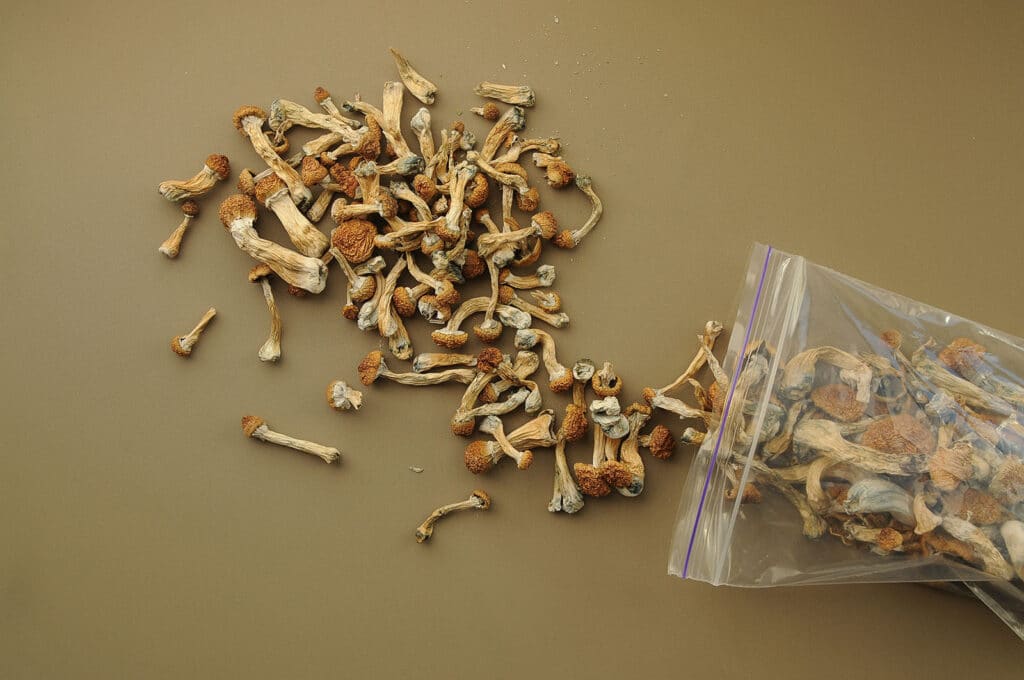
How Long Does the Comedown Last?
Once the peak has been realized, the comedown often lasts another 2 to 3 hours. During this time the effects of the psilocybin gradually wane. Individuals may start to feel reflective. This can lead to introspection and feelings of exhaustion or tiredness.
The aftereffects can last another 12 hours after the dose. This means that most people will experience the effects of the shrooms for between 18 and 24 hours.
Potential Risks of Magic Mushroom Use
The effects of shrooms are not considered addictive. However, it is possible to experience unwanted side effects or even have a bad trip. Some individuals don’t like it when they take shrooms and experience a loss of self. This is also sometimes referred to as ego loss or ego death, and it can be unsettling for some individuals because this causes a temporary loss of identity. Some individuals who have had an unpleasant experience with shrooms also report time feeling like it’s standing still, negative thoughts, paranoia, mood swings and terrifying or unnerving hallucinations.
Individuals who have experienced a bad trip have reported symptoms months and even years later. The symptoms often appear suddenly and dissipate just as suddenly. During these times, individuals may experience confusion, fear or terror, anxiety, severe paranoia and even psychosis.
Factors that Increase the Risk of a Bad Trip
The factors that can increase the risk of experiencing a bad trip include:
- Taking a High Dose – Taking high doses can increase the risk of experiencing a bad trip.
- Not Being in a Relaxed State of Mind – People have better experiences with shrooms when they are relaxed and happy.
- Using Shrooms in a Loud or Stimulating Environment – Being in an overly stimulating environment can increase the risk of experiencing a bad trip.
- Using Shrooms Alone – People report better experiences with shrooms when they take them with friends or as part of a group.
- Being Dehydrated – Not being hydrated can increase the risk of experiencing a bad trip.
- Combining Alcohol and Shrooms – It’s not recommended to combine alcohol and shrooms, since it can increase the chances of experiencing a bad trip.
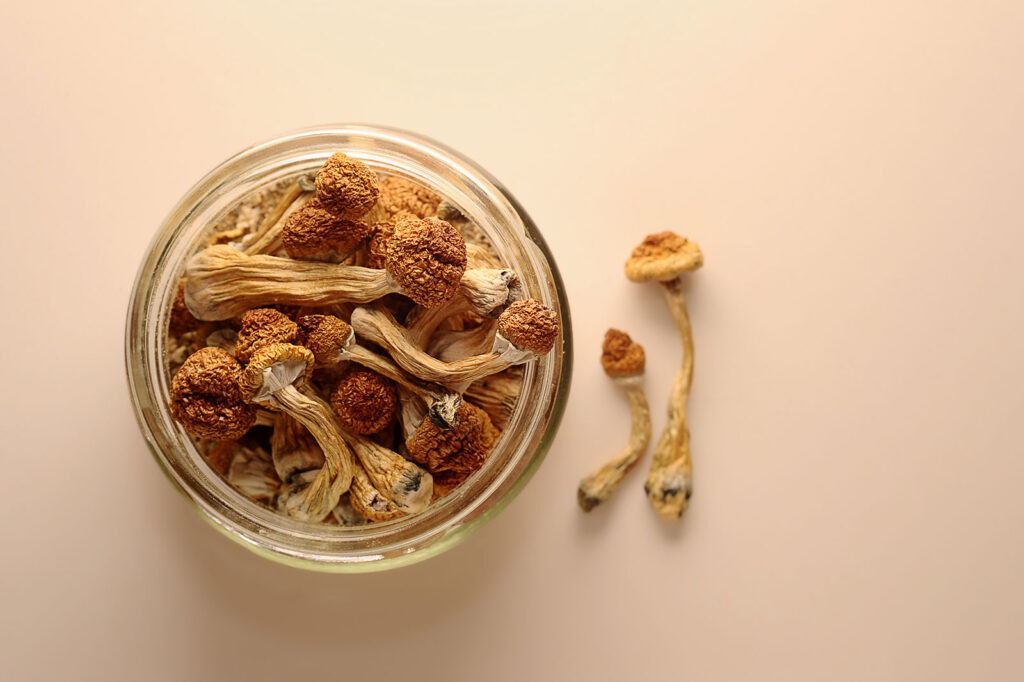
Signs of a Bad Trip and How to Handle It
Individuals who are having a bad psychedelic trip often experience an increased heart rate and elevated blood pressure. They may breathe faster, have a fever or begin sweating excessively. They may also begin to panic and experience paranoia.
While a bad trip can be extremely scary, it is possible to help the individual calm down.
- Recognize the signs of a bad trip.
- Remove external stimuli, like noise and lights, from the area or move the person to a safe, non-stimulating place.
- Do not leave the person experiencing the bad trip alone.
- If the individual becomes dangerous to themselves or others, get medical help.
Treatment Options for Problematic Psychedelic Use
While magic mushrooms aren’t considered addictive, individuals can still experience problematic psychedelic use. This occurs when the individual starts taking the shrooms regularly to incite an altered state of thinking and escape reality. The latter is known as escapism, and while some escapism can help people relax and unwind after a hectic day, too much escapism can lead to problems in daily life.
Detection Times
Psilocybin, the active compound in psychedelic mushrooms, is metabolized relatively quickly in the human body. Detection windows for psilocybin and its metabolite, psilocin, vary depending on the type of drug test administered. Below is a summary of approximate detection times:
| Test Type | Detection Window |
| Urine Test | Up to 24 hours |
| Blood Test | Less than 15 hours |
| Saliva Test | Less than 12 hours |
| Hair Test | Up to 90 days |
Note: Standard drug tests, such as the commonly used 5-panel tests, do not typically screen for psilocybin or psilocin. Detection usually requires specialized testing methods, which are not routinely employed.
Individual factors, including metabolism, dosage, frequency of use, and overall health, can influence these detection windows. For personalized information, it’s advisable to consult with a healthcare professional or a toxicology expert.

Signs the Psychedelic Use is a Problem
- Not being able to control their consumption of shrooms.
- Spending an extreme amount of time under the influence of magic mushrooms.
- Using magic mushrooms in a way that is harmful. For example, while at work, driving or taking care of children.
Individuals who are using too many shrooms may experience nausea or an upset stomach, diarrhea and vomiting. They may also suffer from dizziness, muscle spasms and numbness in the extremities.
If an individual has gone from consuming shrooms occasionally to frequently, it may be time to consider professional help from Recreate Behavioral Health Network.
At Recreate Behavioral Health Network, we offer a range of therapies that can help people cease their use of hallucinogens. Our therapy options include cognitive behavioral therapy, dialectical behavioral therapy, group therapy and even teletherapy.
- Cognitive Behavioral Therapy – This therapy is designed to help people identify their negative thought patterns and question their helpfulness. The individuals are then challenged to create positive thoughts and actions.
- Dialectical Behavioral Therapy – This talk therapy is helpful for individuals who experience strong emotions. It is used to help people better understand and accept themselves and their current situations while teaching them how to identify and stop harmful behaviors.
- Group Therapy – Group therapy is beneficial for teaching people social skills and self-awareness. It also helps people with accountability while providing them with a support system.
- Teletherapy – Teletherapy is done over the telephone or computer. It’s a type of one-on-one psychotherapy that lets people talk about their daily challenges while receiving support from a therapist.
Conclusion
If you’re ready to get help for problematic substance use involving psychedelics, including magic mushrooms, we can help you at Recreate Behavioral Health Network. We offer a variety of behavioral therapies, detox help, and relapse prevention and alumni programs that can help individuals stop using psychedelic drugs and develop positive habits. Understanding the potential impact of psychedelic substances on mental health and overall well-being is crucial, and our programs address the complex factors contributing to substance abuse.
To get help for your magic mushroom dependency or other substance use issues related to psychedelic compounds and their psychoactive effects, give us a call today. We are here to support your journey toward wellness and can connect you with the healthcare professionals you need.





